Members of the Fringillidae family, finches are nimble songbirds that come in a kaleidoscope of beautiful colors. Despite their small, compact size, these little birds are feathery powerhouses, with tough beaks for cracking open nuts and seeds. Let’s take a look at the finches that call Florida home and learn how to properly ID each bird!
1. American Goldfinch (Spinus tristis)
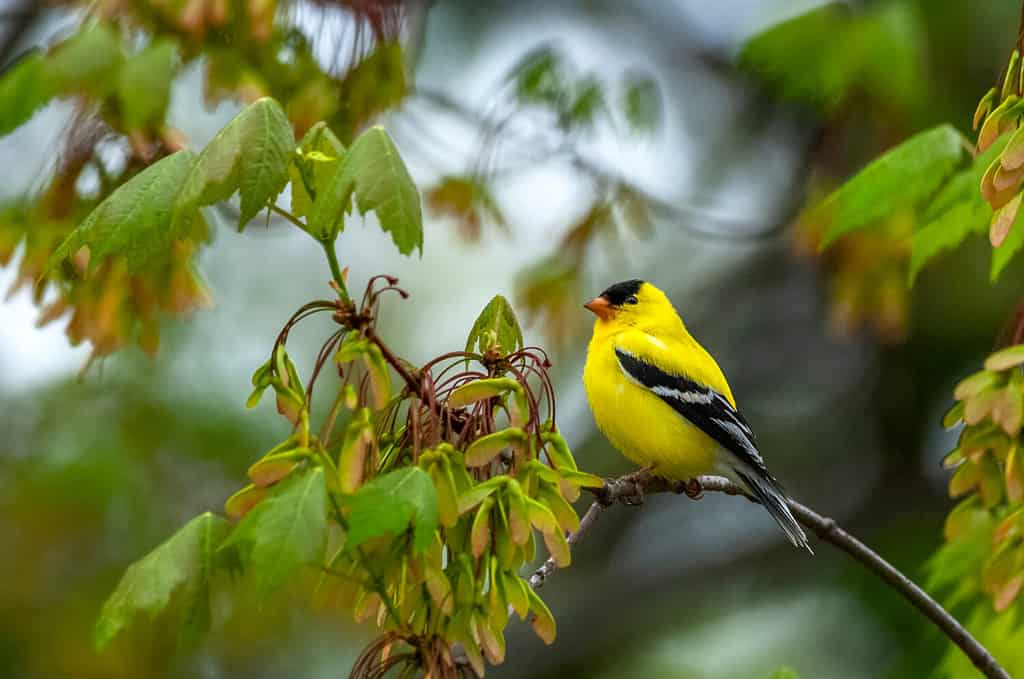
American goldfinches spend time in areas with abundant plants like sunflowers, dandelions, and thistles.
©Alan B. Schroeder/Shutterstock.com
Found throughout North America, the American goldfinch is easy to spot due to its vibrant yellow feathers. In Florida, these cheerful birds prefer partially open areas, with a nice mixture of scattered trees, shrubs, and low vegetation. American goldfinches in Florida are often spotted along the edges of woodlands and forests, in weedy meadows and fields, in fields and orchards, and even in suburban backyards.
How to Identify American Goldfinches
| Category | Answer |
|---|---|
| Size | About 4.3 to 5.1 inches long. |
| Males | During the breeding season, male birds sport vibrant yellow feathers, accented by black wing bars with white patches and black foreheads. Outside of the breeding season, they have drab brown feathers, sometimes with a yellowish head. |
| Females | Female birds have pale yellow or brownish/olive-brown feathers and bold black and white bars on their wings. During the breeding season, they have yellow feathers below. They look similar to the males, but are paler or duller yellow and lack the bold black feathers on the head. |
2. Lesser Goldfinch (Spinus psaltria)
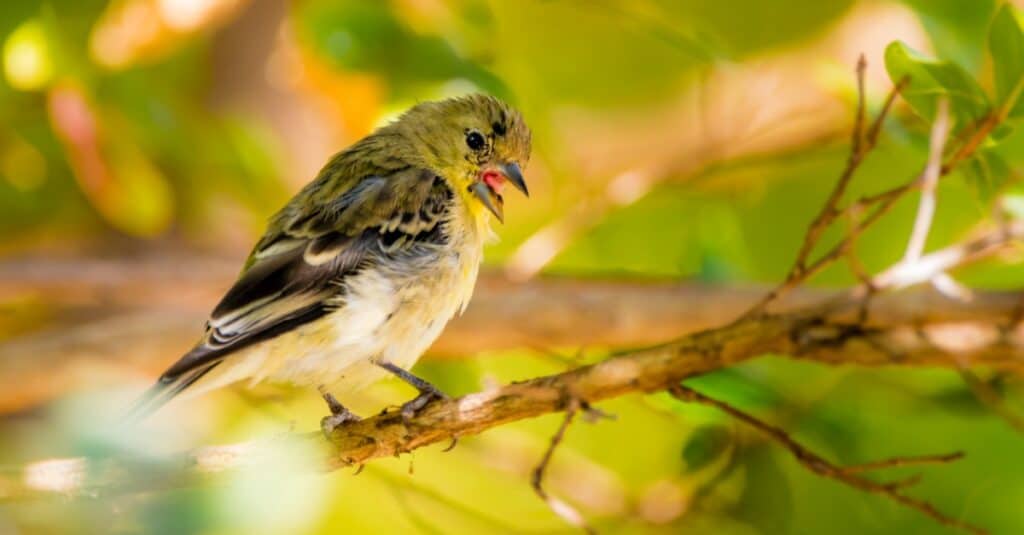
The lesser goldfinch is slightly smaller than the American goldfinch.
©iStock.com/Sunil Singh
Although smaller than the American goldfinch, the lesser goldfinch is just as bright and beautiful. These acrobatic birds have dazzling bright yellow feathers that make them easy to spot as they flit about. They prefer partially open habitats, with a nice mixture of weedy fields, trees, and shrubs. In Florida, they often frequent open fields, the edges of woodlands, and coastal scrublands, especially during the spring and summer months. They particularly like sunflower, daisy, and thistle seeds.
How to Identify Lesser Goldfinches
| Category | Answer |
|---|---|
| Size | About 4 to 5 inches long. |
| Males | Adult males have bright yellow feathers with glossy black caps. Their backs are dark, either black or dull green. Their wings are also dark and have white patches. |
| Females and immature males | Female and young male birds have olive feathers with dull yellow underneath. Their black wings have white bars. |
3. House Finch (Haemorhous mexicanus)

Finches are very vocal and musical.
©Real Window Creative/Shutterstock.com
If you live in Florida, you’ve likely come across a house finch at some point. These sweet little birds often live in urban areas like parks and residential neighborhoods, favoring human-modified habitats that provide plenty of shelter and food to eat. They are very social birds, flocking together in musical groups as they munch on fruits, seeds, and insects.
How to Identify House Finches
| Category | Answer |
|---|---|
| Size | 5.1 to 5.5 inches long. |
| Males | Male house finches are easy to spot, with vibrant, rose-colored feathers on their heads and breasts. However, depending on their diet, some birds have more yellow or orange coloring in place of these rose-red feathers. Their bodies and wings sport streaks of brown. |
| Females and immature males | Female birds and young males have brown or grayish-tan bodies with blurry streaks of various brown hues |
4. Purple Finch (Haemorhous purpureus)

Purple finches have unique warbling songs.
©Fiona M. Donnelly/Shutterstock.com
In Florida, purple finches are not quite as common as some of their other cousins. They primarily visit the state during the winter months, from October through April. Purple finches typically prefer forest habitats with coniferous trees, mixed woodlands, and occasionally suitable backyards (often ones with lots of sunflower seeds!). They spend much of their time in the highest part of the trees.
How to Identify Purple Finches
| Category | Answer |
|---|---|
| Size | Around 4.7 to 6.3 inches long. |
| Males | Purple finches get their name from the beautiful purplish-red colors of male birds — they look as if they have eaten one too many raspberries! This stunning raspberry-red coloring is seen on their heads, breasts, backs, and rumps, while there are streaks of brown on their backs and wings. |
| Females and immature males | Females and young male birds are much more subdued than male birds and lack the raspberry red coloring. Instead, their bodies are boldly streaked with brown and white. |
5. Pine Siskin (Spinus pinus)
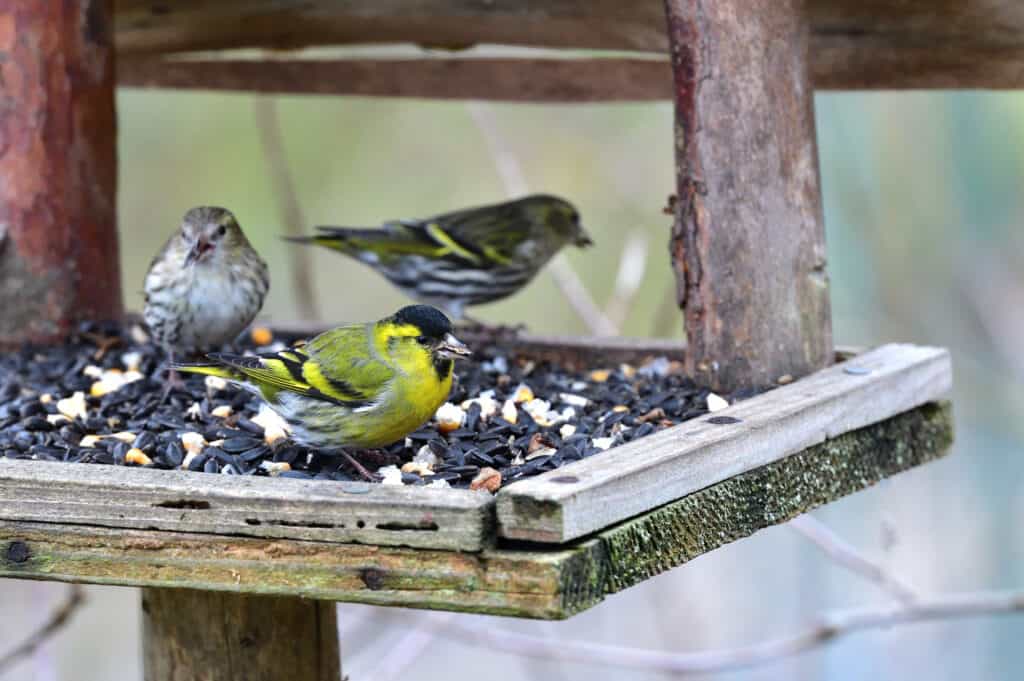
Pine siskins particularly like sunflower, nyjer, and thistle seeds.
©Klimek Pavol/Shutterstock.com
Sometimes spotted in Florida during the winter months, the pine siskin is an energetic finch that often visits the northern and central regions of the state. These charming little birds prefer forested areas and mixed woodlands with plenty of seeds to eat. You can often hear their high-pitched, twittering calls even when you can’t see them. However, if you are lucky enough to see them, they are a lot of fun to watch. Pine siskins are acrobatic feeders, which means that they often hang upside down to get seeds.
How to Identify Pine Siskins
| Catefory | Answer |
|---|---|
| Size | Around 4.3 to 5.5 inches long. |
| Males | Male birds have brownish feathers on top with heavy dark brown streaks. Underneath their feathers are paler and have lighter-colored streaks. During the breeding season, however, males have a yellow breast and yellow bars on their wings. |
| Females | Female birds also have brownish feathers with very bold streaks. |
6. Evening Grosbeak (Hesperiphona vespertina)
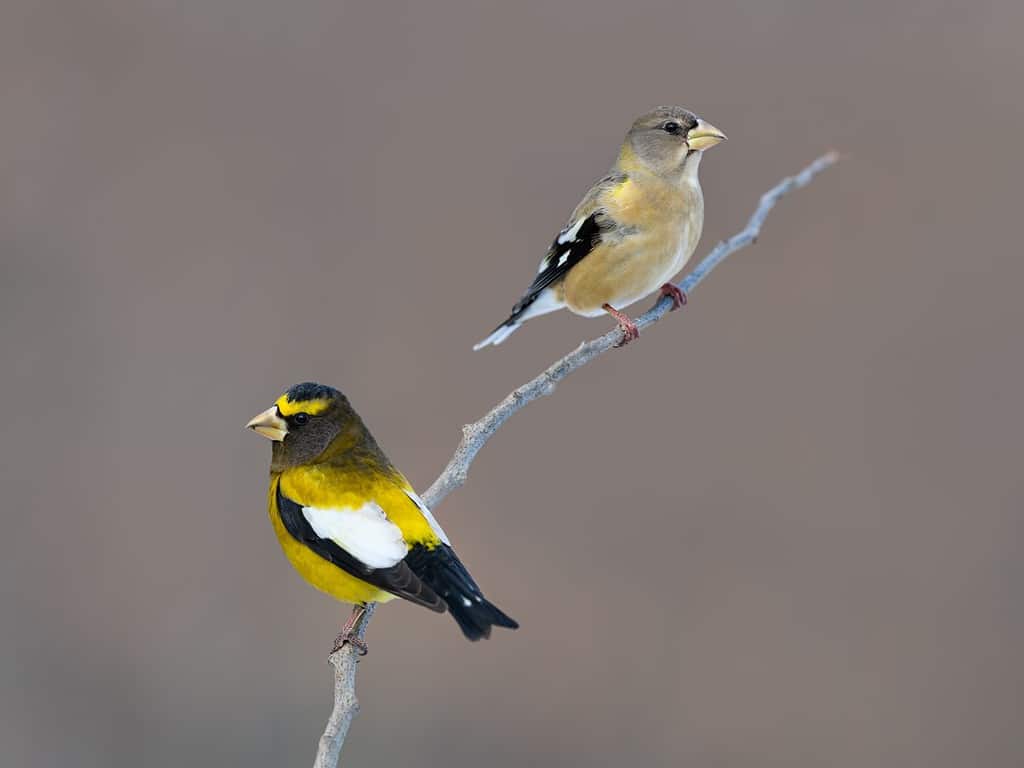
Evening grosbeaks sometimes visit backyards stocked with delicious sunflower seeds.
©FotoRequest/Shutterstock.com
A rather chunky-looking finch, the evening grosbeak is another winter visitor in Florida. These birds are pretty unpredictable, and their migratory patterns are based heavily on the availability of food. Evening grosbeaks prefer mixed woodlands and coniferous forests but can also be seen along the edges of woodlands and clearings.
How to Identify Evening Grosbeaks
| Category | Answer |
|---|---|
| Size | Around 7.9 to 9.1 inches long with stocky bodies. |
| Males | Male birds have beautiful yellow feathers, with dark gray or black heads. They have a bright yellow stripe over each eye and prominent white patches on their wings. |
| Females and Immature Males | Female and young male birds have mostly gray feathers, with bold black and white patterns on their wings. There is also a tinge of yellow or greenish yellow around their necks. |
7. Red Crossbill (Loxia curvirostra)

Red crossbills have unique mandibles that cross over one another.
©Henk Bogaard/Shutterstock.com
These medium-sized finches favor areas with lots of cone-bearing coniferous trees like spruce and pine. The upper and lower portions of their unique bills cross over one another, a special design that allows them to access the seeds in pinecones.
How to Identify Red Crossbills
| Category | Answer |
|---|---|
| Size | Typically 5.9 to 7.5 inches long, with stocky bodies. |
| Males | Males have red or reddish-orange bodies with darker brownish-red wings. |
| Females | Female birds have yellowish-colored feathers with darker wings. |
| Juveniles | Young red crossbills are brownish-gray with heavy streaking. |
8. Common Redpoll (Acanthis flammea)
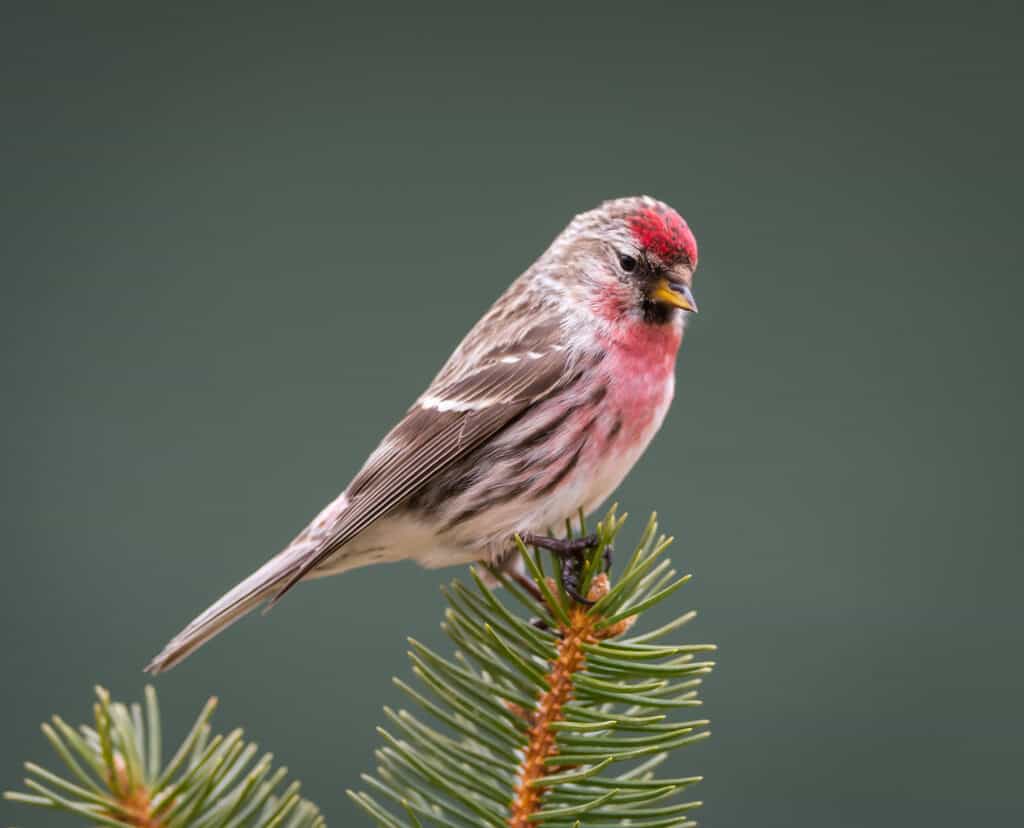
Common redpolls are very social, communicating with high-pitched songs in large flocks.
©FotoRequest/Shutterstock.com
Hailing from the boreal forests of the arctic tundra, the common redpoll is not a typical visitor to Florida. However, there have been occasional rare sightings of these beautiful birds in the state during the winter months. Common redpolls are very active, energetic birds that can be seen and heard in open landscapes like meadows and fields. They may also be spotted on occasion in marshes, wetlands, and backyards with feeders (they especially love thistle and nyjer seeds).
How to Identify Common Redpolls
| Category | Answer |
|---|---|
| Size | Around 4.3 to 5.1 inches long. |
| Males | Male birds have brown-streaked bodies with light-colored undersides. Their most distinguishing feature is the vibrant red feathers on the crown of the head and the pinkish-red feathers on their chest. |
| Females and immature males | Female and young male birds have brown bodies with lots of streaks. Their undersides are lighter, and they have a tiny little red patch of feathers on the crown of the head. |
9. Yellow-Fronted Canary (Crithagra mozambica)

The yellow-fronted canary is also called the green-singing finch.
©Utopia_88/iStock via Getty Images
Although the yellow-fronted canary hails from sub-Saharan Africa, a few of these unique birds have been spotted in Florida. These beautiful yellow birds have high-pitched songs with sweet melodies. Yellow-fronted canaries typically prefer grasslands and open woodlands, but may also be seen in sand dunes, coastal scrub, and mangroves.
How to Identify Yellow-Fronted Canaries
| Category | Answer |
|---|---|
| Size | Around 4 to 5 inches long. |
| Males | Adult male birds have bright yellow feathers, with dark stripes through the eyes and below the beak. Their backs and wings are darker with faint outlines of yellow. |
| Females | Although similar to males in appearance, female yellow-fronted canaries are much less brightly colored. |
Uncommon Visiting Finches in Florida
Extremely Rare Finches Spotted in Florida
In addition to the many finches that call Florida home, a few unexpected species have been spotted around the state. However, these are extremely rare, and some have only been observed once in Florida:
- White-winged crossbill (Loxia leucoptera)
- Common chaffinch (Fringilla coelebs)
- European Goldfinch (Carduelis carduelis)
- European Greenfinch (Carduelis chloris)
“False” Finches in Florida
“True” finches belong to the scientific family Fringillidae, including birds like redpolls, siskins, canaries, grosbeaks, serins, and euphonias. These birds are typically small, colorful, and have tiny conical beaks. However, many other birds are also referred to as finches, even though they are not truly part of the finch family at all. These are the “false” finches you may come across in Florida:
- Scaly-breasted munia (Lonchura punctulata)
- Tricolored munia (Lonchura malacca)
- Rose-breasted grosbeak (Pheucticus ludovicianus)
- Black-headed grosbeak (Pheucticus melanocephalus)
- Blue grosbeak (Passerina caerulea)
- Lazuli bunting (Passerina amoena)
- Indigo bunting (Passerina cyanea)
- Varied bunting (Passerina versicolor)
- Painted bunting (Passerina ciris)
- Cuban bullfinch (Melopyrrha nigra)
- Greater Antillean bullfinch (Melopyrrha violacea)
The photo featured at the top of this post is © Rejean Bedard/iStock via Getty Images
Thank you for reading! Have some feedback for us? Contact the AZ Animals editorial team.






